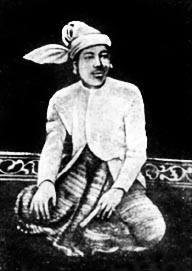
August 1866
The assassination of the Prince of Kanaung
people King Mindon Prince of Kanaung Prince of Myingun
In August 1866, the course of Burmese history changed forever with the assassination of the Prince of Kanaung. The Kanaung Prince was the Crown Prince, the younger brother of King Mindon and also his partner in government. Together they set out to transform government, develop the economy, and defend the country's independence. It was a modernization programme that preceded what would be tried elsewhere, in Japan, Siam, Egypt, Vietnam.
Under the Kanaung Prince's direction: dozens of students were sent to Europe, to study science and engineering and for military training; the army was overhauled; modern factories were built, including for arms and ammunition, iron-works, and glassware; a telegraph line was established; and ten steamships were imported from England for a new state-run transport system. One of the world's first oil industries was started. High tariffs protected local industries. The state also organized the production and export of cotton to take advantage of high global prices, the result of the American Civil War. These and other state-directed exports financed the country's modernization. As importantly, the entire fiscal and administration basis of government was reviewed and fundamental reforms begun, on issues from agricultural taxation to bureaucratic organisation.
At around noon on 2 August 1866, the 46-year-old Prince of Kanaung, together with ministers and secretaries, were killed by men loyal to his nephew, the Prince of Myingun. Civil war then broke out between loyalist forces under the king and rival princely factions. After weeks of savage fighting up and down the Irrawaddy River, King Mindon was eventually able to overcome his opponents, but his reform programme had been critically weakened. The king himself was never the same and he never again appointed a new crown prince. No one was actually against the reforms; the princes responsible for the rebellion were motivated by anger from past slights, a desire for power, and a feeling they could do better.
In 1867, taking advantage of internal strife, the British forced the Burmese government to sign a commercial treaty. The treaty, amongst other things, lowered tariffs and ended state involvement in the economy. Also over the late 1860s, the Taiping and Panthay rebellions to the northeast made impossible the development of trade with China. All of this led to a severe fiscal crisis and by the mid-1870s, very little of King Mindon and the Kanaung Prince's original development programme was left. While these outside factors were important in undermining their reforms, in the end it was intra-elite rivalries - the inability of Burmese leaders to come together at a time of crisis - that doomed the country.
Explore more in Late Konbaung Myanmar and the English Wars (1824-1885AD)